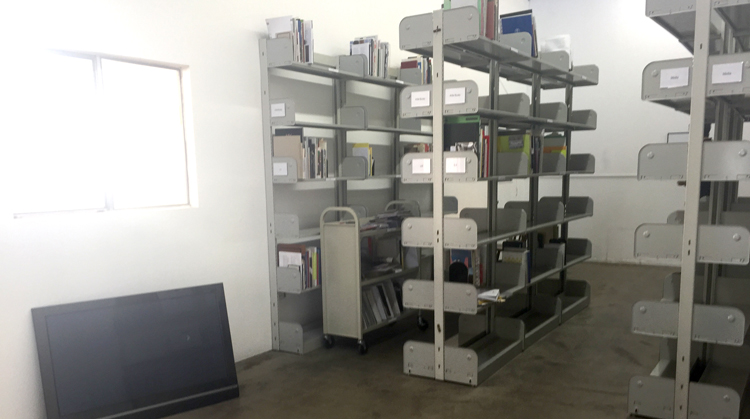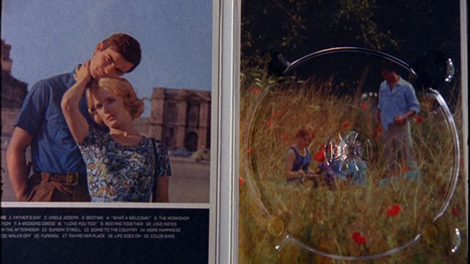When I enter the Los Angeles Contemporary Archive for the first time, I know that I have not viewed art in any space like it before. The venue bridges the gap between gallery space and archive —the exhibit’s content is displayed among boxes of materials, shelves of books, and tables where archivists are hard at work.
The exhibits, curated by Suzy Halajian, are divided into two rooms: the main archive space and the workspace. They are unlabeled and visitors rely on helpful information sheets to deduce which piece is which.
Navigating the space entails moving through these materials and remarkably focused archivists, and the non-conclusiveness of it makes me initially a bit uneasy. The goal of this layout—I read on the information sheet—is to provide a space of “self-directed meditation.” So I sit down in the main archive area on the concrete floor in front of a video installation by New York artist Alejandro Cesarco. Titled If in Time, the film depicts two characters communicating solely by reading texts aloud to each other, which the viewer reads through subtitles. The work seems to be largely a reflection on the selfhood of artists, with a female reading her own text and a male responding with what he is writing about her text. Additionally, the reality versus unreality of art and fiction is explored, with one of the individuals claiming, “What we are capable of imaging always exists,” but also that the readers can “inhabit false lives in the gullibility of the listener.” They lament the condemnation of inhabiting only one life or way of being, and seem to treat the creation of their own oblique truths as means of avoiding this fate.
Cesarco also has three prints, A Portrait of the Artist Approaching Forty displayed in the same room, which depict scratches, holes and imperfections that fill his studio. The presentation of the workplace of the artist within the workplace of archivists is a compelling, textural layering.
Steve Roden’s knockin on heaven’s door repeats the motif of the opening and closing of a door presenting an image behind the door with each opening. The continuity between the images is unclear, but I am informed that the images are both personal and isolated. The film cuts each time the door closes, thus presenting each opening as its own, singular event. I wondered whether the film might view more smoothly without these cuts, but the artist certainly accomplished his goal of presenting orphaned images through this format.
Perhaps the most striking of the video installations is Hysterical Choir of the Frightened, from Cairo artist Doa Aly. It might be easy to miss, as the room where it is screened is behind a door that looks as though it might be a storage closet; the only tipoff being a low murmur of female voices escaping through the door. Indeed, the film features four women quietly reciting Marquis de Sade’s 1791 text Justine in round, next taking up an Egyptian newspaper article on the most recent Cairo protests. The camera circles the women, who are both united through the recitation of the content and isolated through their individual timing and understandability (the viewer is unable to decipher much of what is said).
The idea of return is the one that permeates through all the pieces and acts as a unifying force for the exhibit. As the information sheet explains, “As the artists in this project return to and re-read material, an affected consideration of words, sounds, and objects emerges.” The LA Contemporary Archive provides an unconventional entry point into the contemplations of what is obliterated, remembered, or experienced as new when artists and viewers return to sources.
The Recorder Was Left On, or The Closer I Get To The End The More I Rewrite The Beginning
Doa Aly, Alejandro Cesarco, Yann Novak, and Steve Roden
Curated by Suzy Halajian
Los Angeles Contemporary Archive (LACA)
www.lacarchive.com
Ends September 26, 2015




